By Leen Randell
Updated: Jul 04, 2024
10 Best Herbal Decoctions For Plantar Fasciitis
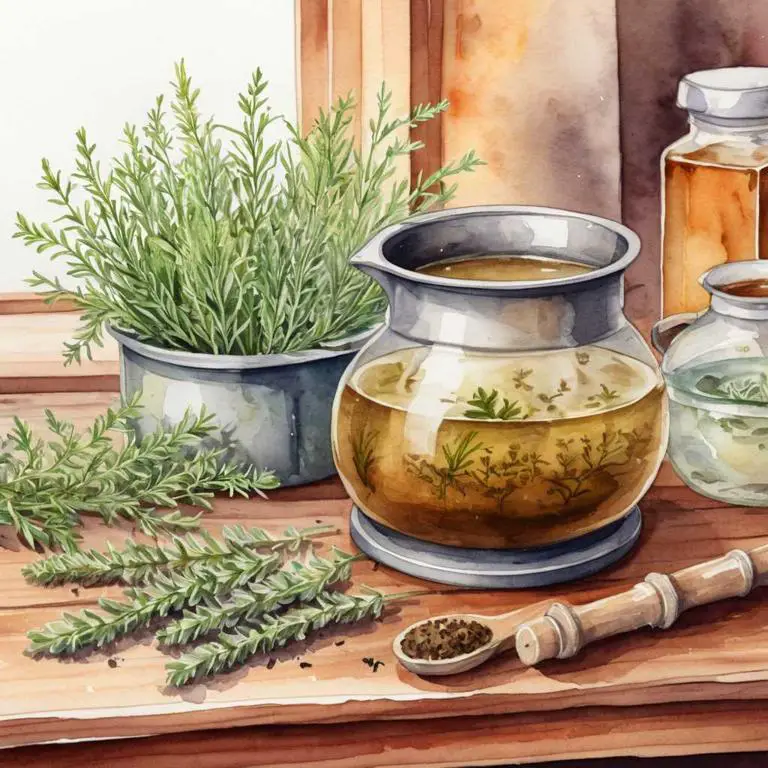
Herbal decoctions for plantar fasciitis are a natural remedy that involves steeping herbs in hot water to create a soothing liquid that can be used to alleviate symptoms of this common condition.
These decoctions help by reducing inflammation, relieving pain and stiffness, and promoting healing in the affected area. For example, decoctions made with turmeric, ginger, and willow bark have anti-inflammatory properties that can provide relief from plantar fasciitis pain.
By using these herbal remedies, individuals can experience improved mobility and reduced discomfort, allowing them to resume their daily activities without restriction.
The following article describes in detail the most important decoctions for plantar fasciitis, including medicinal properties, parts of herbs to use, and recipes for preparations.
- 1. Curcuma longa
- 2. Zingiber officinale
- 3. Salix alba
- 4. Harpagophytum procumbens
- 5. Capsicum annuum
- 6. Boswellia serrata
- 7. Withania somnifera
- 8. Echinacea angustifolia
- 9. Eucalyptus globulus
- 10. Mentha x piperita
- What is the best combination of herbal decoctions to use for plantar fasciitis?
- What ailments similar to plantar fasciitis are treated with herbal decoctions?
1. Curcuma longa
Turmeric decoctions helps with plantar fasciitis because of its potent anti-inflammatory and analgesic properties.
The active compound curcumin in turmeric has been shown to reduce inflammation and alleviate pain in the heels, arches, and soles of the feet, common areas affected by plantar fasciitis. Additionally, turmeric decoctions have natural antioxidant properties that help protect tissues from further damage, promoting faster recovery and reducing the risk of chronic pain and stiffness.
Regular consumption of turmeric decoctions may also improve flexibility and reduce morning stiffness.
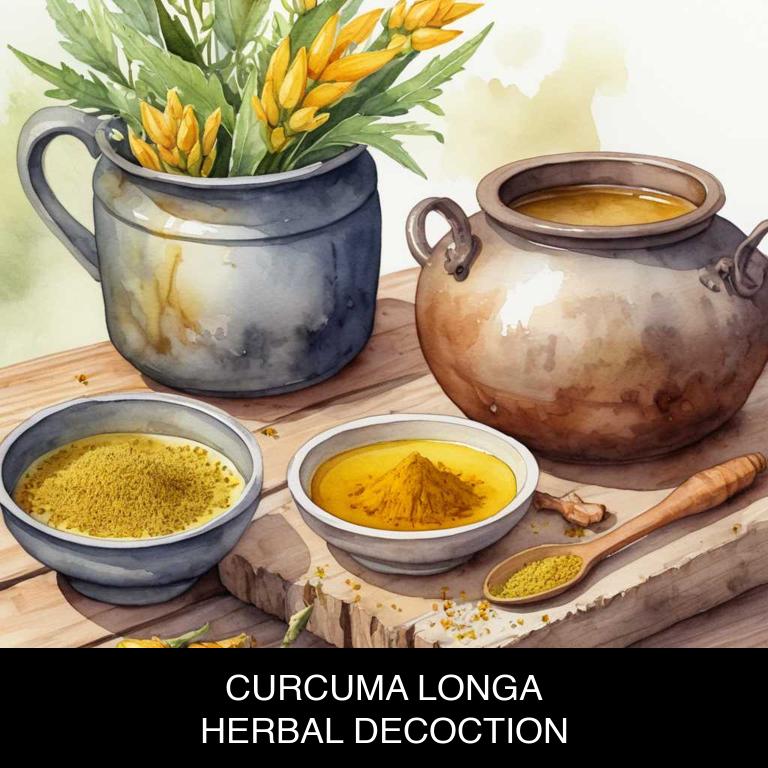
Medicinal Constituents
The list below shows the primary medicinal constituents in Curcuma longa decoctions that help with plantar fasciitis.
- Curcumin: Curcumin, a polyphenolic compound, has potent anti-inflammatory properties that help reduce pain and inflammation associated with plantar fasciitis.
- Cucurbitacin e: Cucurbitacin E, a triterpenoid saponin, possesses anti-inflammatory and antioxidant properties that help alleviate pain and swelling in the plantar fascia.
- Demethoxycurcumin: DMC, a curcuminoid, has been shown to have anti-inflammatory and antioxidant effects, which help reduce inflammation and promote healing in the affected area.
Parts Used
The list below shows the primary parts of turmeric used to make decoctions for plantar fasciitis.
- Rhyzomes: Rhyzomes are the most commonly used part, as they contain high amounts of curcumin, a compound with anti-inflammatory properties that helps reduce pain and inflammation associated with plantar fasciitis.
- Roots: Roots are also widely used, as they contain a similar profile of bioactive compounds to the rhyzomes, including curcumin, which contributes to their therapeutic effects.
- Seeds: Seeds are sometimes used, as they have been found to contain curcuminoids, which may help to reduce inflammation and alleviate symptoms of plantar fasciitis.
Quick Recipe
The following recipe gives a procedure to make a basic turmeric for plantar fasciitis.
- Choose fresh or dried curcuma longa roots with no visible mold or damage for decoction.
- Measure one to two teaspoons of curcuma longa roots per cup of water for decoction.
- Boil 8 to 10 cups of water in a large pot for five to seven minutes.
- Add measured curcuma longa roots to boiling water and reduce heat for 20 to 30 minutes.
- Strain the liquid from the curcuma longa roots using a fine-mesh sieve and discard solids.
2. Zingiber officinale
Ginger decoctions helps with plantar fasciitis because of its natural anti-inflammatory properties, which alleviate pain and swelling in the affected area.
The decoction's warming effects also help to increase blood flow, reducing stiffness and discomfort in the heel and ankle. Additionally, ginger's antioxidant properties may help to reduce inflammation-causing free radicals, promoting a faster recovery from plantar fasciitis.
As a result, herbal ginger decoctions can provide relief from plantar fasciitis symptoms, allowing individuals to resume their normal activities with ease.
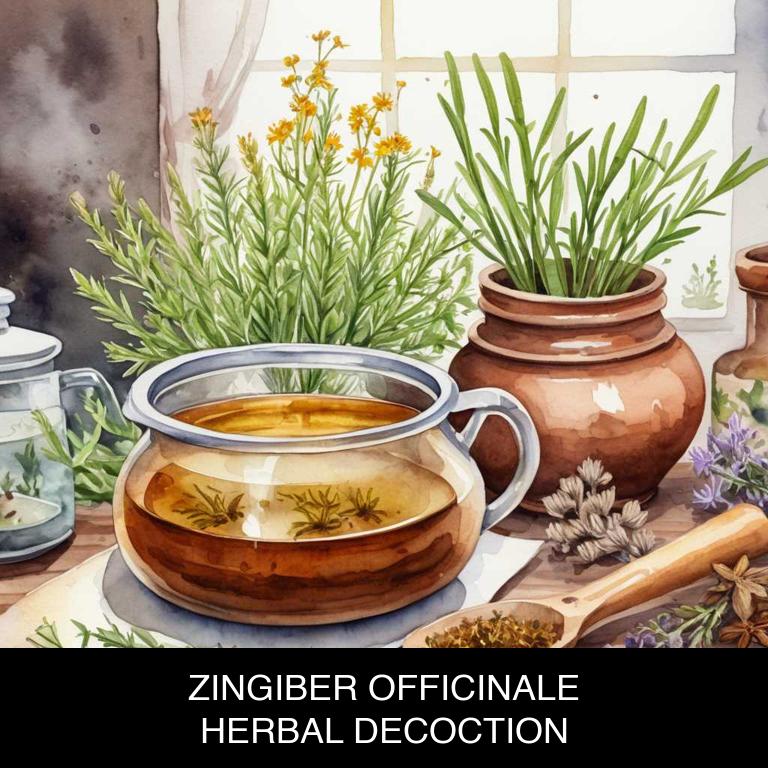
Medicinal Constituents
The list below shows the primary medicinal constituents in Zingiber officinale decoctions that help with plantar fasciitis.
- Gingerols: These gingerols, particularly 6-gingerol, have anti-inflammatory properties that help reduce pain and inflammation in the plantar fascia, alleviating symptoms of plantar fasciitis.
- Shogaols: Shogaols, such as 6-shogaol, have potent anti-inflammatory and analgesic effects, which help reduce pain and swelling in the affected area, providing relief from plantar fasciitis.
- Zingerone: Zingerone has anti-inflammatory and antioxidant properties that help reduce oxidative stress and inflammation in the plantar fascia, contributing to its potential therapeutic benefits for plantar fasciitis.
Parts Used
The list below shows the primary parts of ginger used to make decoctions for plantar fasciitis.
- Rhyzomes: Rhyzomes are the most commonly used part due to their high concentration of gingerols, compounds that help reduce inflammation and pain associated with plantar fasciitis.
- Roots: The roots of Zingiber officinale are also used for their anti-inflammatory properties, which help alleviate pain and discomfort caused by plantar fasciitis.
- Buds: The buds of Zingiber officinale are used for their anti-inflammatory and analgesic properties, which help reduce swelling and pain in the affected area of plantar fasciitis.
Quick Recipe
The following recipe gives a procedure to make a basic ginger for plantar fasciitis.
- Harvest 10-15 fresh zingiber officinale roots weighing approximately 100g for optimal flavor.
- Clean the harvested roots thoroughly with cold running water to remove any dirt or debris.
- Slice the cleaned zingiber officinale roots into thin pieces weighing about 50g and set aside.
- Combine the sliced roots with 2 liters of boiling water and let it steep for 5-7 minutes.
- Strain the decoction using a cheesecloth or a fine-mesh sieve to remove any solid particles.
3. Salix alba
White willow decoctions helps with plantar fasciitis because of its anti-inflammatory properties, which help to reduce pain and swelling in the affected area.
The salicin present in white willow bark is a natural analogue of aspirin, providing relief from inflammation and discomfort associated with plantar fasciitis. Additionally, the decoction's analgesic effects help to alleviate pain and stiffness, allowing for improved mobility and reduced strain on the affected foot.
This natural remedy can provide long-lasting relief for individuals suffering from plantar fasciitis.
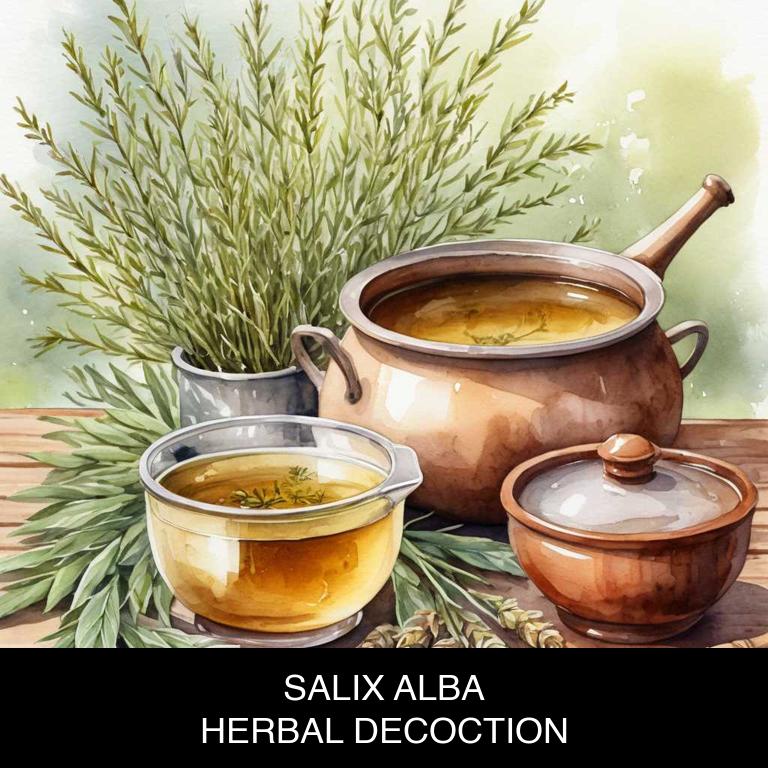
Medicinal Constituents
The list below shows the primary medicinal constituents in Salix alba decoctions that help with plantar fasciitis.
- Salicin: A phenolic glycoside, salicin helps reduce inflammation and pain associated with plantar fasciitis by inhibiting the production of pro-inflammatory enzymes.
- Salicylic acid: A phenolic acid, salicylic acid helps break down and remove dead skin cells and reduce inflammation in the affected area, promoting healing and reducing pain.
- Triterpenoids: A group of compounds including ursolic acid and oleanolic acid, triterpenoids help reduce inflammation and oxidative stress in the affected area, promoting healing and reducing pain associated with plantar fasciitis.
Parts Used
The list below shows the primary parts of white willow used to make decoctions for plantar fasciitis.
- Leaves: The leaves of the plant are used for their antiseptic and anti-inflammatory properties, which can help soothe and calm irritated tissues.
- Buds: The buds of Salix alba contain compounds with anti-inflammatory and antimicrobial properties, making them effective in treating plantar fasciitis.
Quick Recipe
The following recipe gives a procedure to make a basic white willow for plantar fasciitis.
- Harvest 25 grams of salix alba bark and rinse it with cold water to remove dirt and impurities.
- Chop the salix alba bark into small pieces to increase the surface area for infusion.
- Combine the chopped bark with 500 milliliters of water in a saucepan and bring to a boil.
- Reduce the heat to a simmer and let the decoction steep for 10 to 15 minutes.
- Strain the decoction through a cheesecloth or a fine-mesh sieve into a clean container.
4. Harpagophytum procumbens
Devil's claw decoctions helps with plantar fasciitis because it contains harpagosides, a natural compound that reduces inflammation and relaxes muscle tension.
By decreasing pain and stiffness, devil's claw decoction can help alleviate the discomfort associated with plantar fasciitis. The anti-inflammatory properties also aid in reducing swelling and bruising around the heel and ankle, allowing for improved mobility and reduced strain on the affected area.
As a result, patients experiencing plantar fasciitis may experience significant relief from pain and discomfort when using herbal devil's claw decoctions as part of their treatment plan.
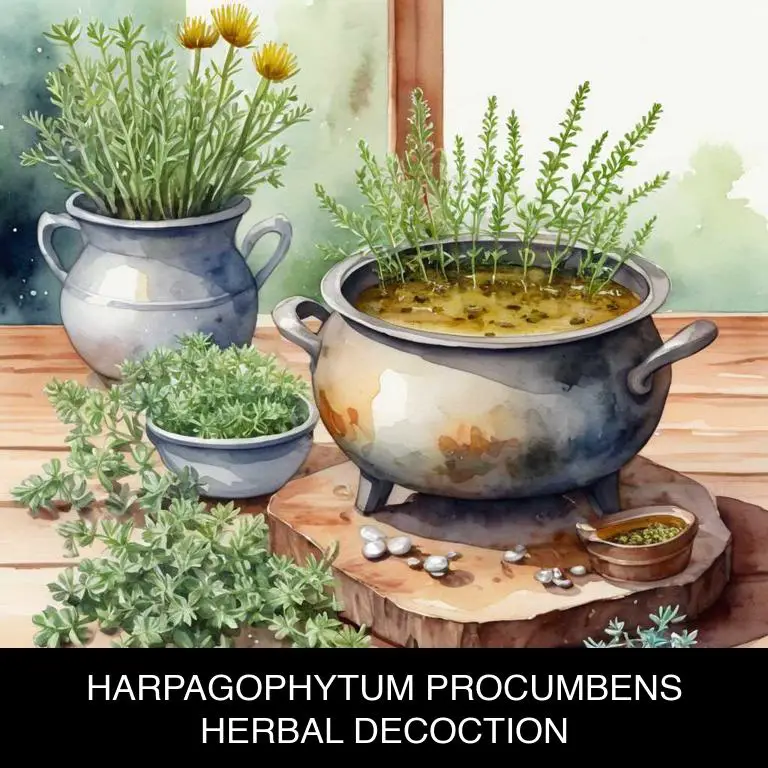
Medicinal Constituents
The list below shows the primary medicinal constituents in Harpagophytum procumbens decoctions that help with plantar fasciitis.
- Harpagoside: It has anti-inflammatory and analgesic properties, which help reduce pain and swelling associated with plantar fasciitis.
- Iridoid glycosides: These compounds have anti-inflammatory and antioxidant properties, which help reduce inflammation and oxidative stress in the affected area, thus alleviating plantar fasciitis symptoms.
- Phenolic acids: They exhibit anti-inflammatory and antioxidant properties, which help reduce inflammation and promote healing in the affected area, thus providing relief from plantar fasciitis.
Parts Used
The list below shows the primary parts of devil's claw used to make decoctions for plantar fasciitis.
- Roots: Rich in harpagoside, a bioactive compound believed to reduce inflammation and alleviate pain.
- Leaves: Used as a substitute for roots in some cases, but less studied and less effective.
- Buds: Not commonly used, but may be used to make decoctions or teas due to their potential anti-inflammatory properties.
Quick Recipe
The following recipe gives a procedure to make a basic devil's claw for plantar fasciitis.
- Gather harpagophytum procumbens roots weighing 10-20 grams and clean them thoroughly with water.
- Chop the roots into small pieces to increase their surface area for extraction.
- Combine the chopped roots with 1 liter of boiling water in a saucepan and reduce heat.
- Allow the mixture to steep for 10-15 minutes to facilitate the extraction of active compounds.
- Strain the decoction through a cheesecloth or a fine-mesh sieve into a container.
5. Capsicum annuum
Bell pepper decoctions helps with plantar fasciitis because they possess anti-inflammatory compounds that reduce swelling and pain in the affected area.
The decoction's active ingredients, such as capsicum and flavonoids, work to relax tense muscles and reduce inflammation in the plantar fascia, promoting healing and reducing stiffness.
Additionally, bell pepper decoctions may also help to improve blood flow, which can aid in the delivery of oxygen and nutrients to the affected area, further supporting the body's natural healing process.
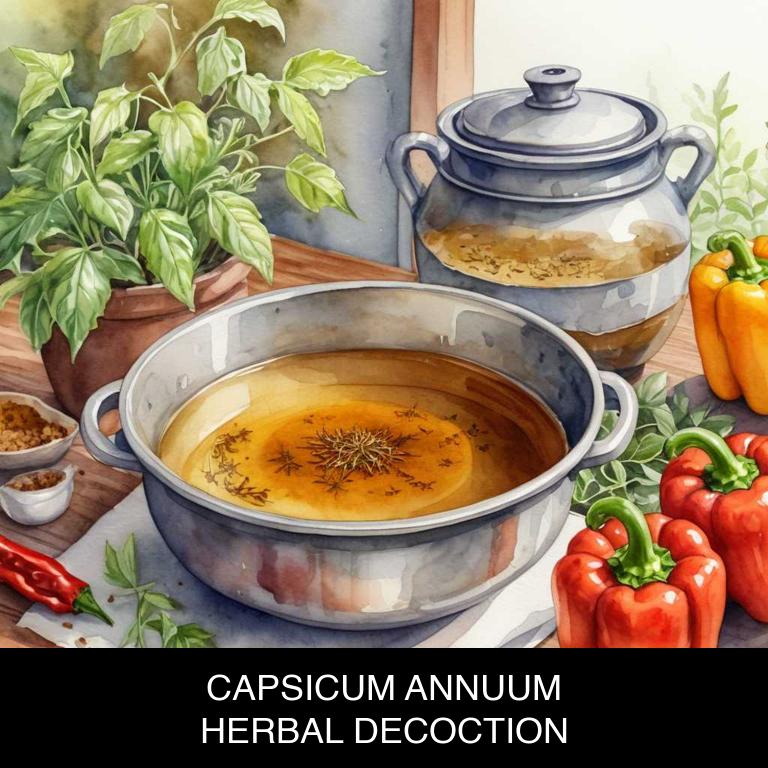
Medicinal Constituents
The list below shows the primary medicinal constituents in Capsicum annuum decoctions that help with plantar fasciitis.
- Capsaicin: Capsaicin, a phenolic compound, helps reduce pain and inflammation associated with plantar fasciitis by blocking the release of pain-causing chemicals, such as substance P.
- Beta-carotene: Beta-carotene, a carotenoid, is converted into vitamin A in the body, which plays a crucial role in maintaining healthy skin and connective tissue. This may help reduce inflammation and promote healing in the affected area.
- Quercetin: Quercetin, a flavonoid, has potent anti-inflammatory and antioxidant properties, which may help reduce swelling and pain in the plantar fascia by inhibiting the production of pro-inflammatory enzymes.
Parts Used
The list below shows the primary parts of bell pepper used to make decoctions for plantar fasciitis.
- Fruits: The most commonly used part for plantar fasciitis decoctions is the fruit (capsaicin-rich peppers), as capsaicin has anti-inflammatory properties that help alleviate pain and inflammation.
- Leaves: Capsicum annuum leaves are also used, as they contain compounds with analgesic and anti-inflammatory effects, which can help reduce pain and swelling associated with plantar fasciitis.
- Seeds: Capsicum annuum seeds, although less commonly used, are sometimes incorporated into decoctions, as they contain capsaicin and other bioactive compounds that may help alleviate plantar fasciitis symptoms.
Quick Recipe
The following recipe gives a procedure to make a basic bell pepper for plantar fasciitis.
- Collect 30-60 grams of fresh capsicum annuum leaves and stems from mature plants.
- Cut the collected plant material into small pieces to release their medicinal properties quickly.
- Boil 1 liter of water in a saucepan over medium heat for 5-7 minutes.
- Add the plant material to the boiling water and reduce heat to low for 10-15 minutes.
- Strain the decoction through a cheesecloth or fine mesh to separate the liquid from solids.
6. Boswellia serrata
Frankincense decoctions helps with plantar fasciitis because they possess anti-inflammatory properties that reduce swelling and pain in the affected area.
The decoction's boswellic acids also help to decrease inflammation-causing enzymes, alleviating strain on the plantar fascia ligament. Additionally, frankincense has analgesic properties that numb the affected area, providing relief from sharp pains and discomfort.
By targeting both inflammation and pain, frankincense decoctions can provide significant relief for individuals suffering from plantar fasciitis, promoting faster healing and improved mobility.
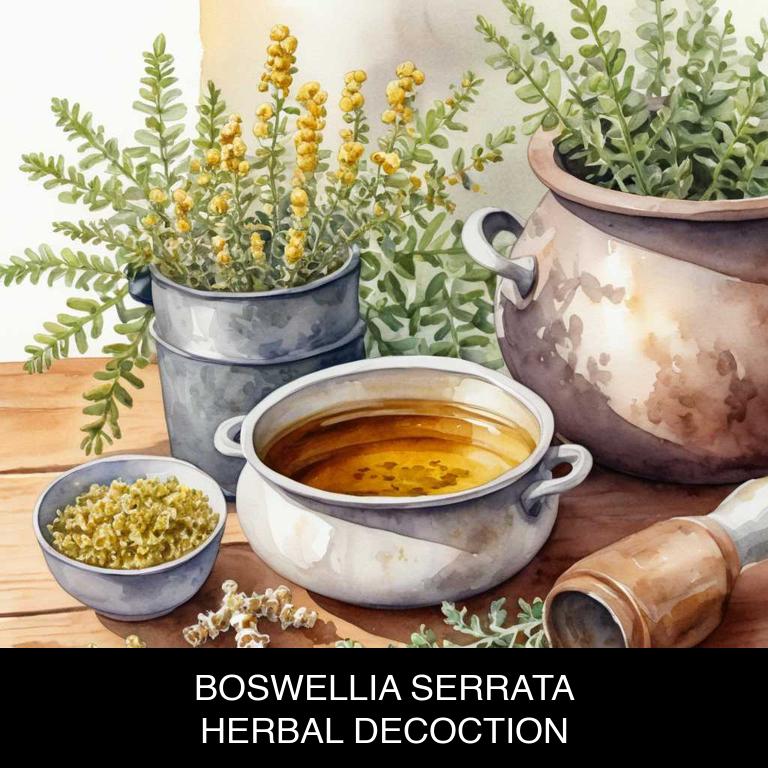
Medicinal Constituents
The list below shows the primary medicinal constituents in Boswellia serrata decoctions that help with plantar fasciitis.
- Terpenoids: These terpenoids have anti-inflammatory and anti-arthritic properties, which can help reduce inflammation and pain associated with plantar fasciitis.
- Phenolic compounds: These compounds exhibit antioxidant and anti-inflammatory activities, which can help protect against oxidative stress and inflammation that contribute to plantar fasciitis.
- Β-boswellic acids: These triterpenoid compounds have been shown to have anti-inflammatory and analgesic properties, which can help reduce pain and inflammation associated with plantar fasciitis.
Parts Used
The list below shows the primary parts of frankincense used to make decoctions for plantar fasciitis.
- Roots: The roots are the most commonly used part of Boswellia serrata for making decoctions due to their high concentration of boswellic acids, which provide anti-inflammatory and analgesic properties.
- Barks: The barks are used to make decoctions for plantar fasciitis as they contain boswellic acids and other compounds that help reduce inflammation and pain.
- Rhyzomes: The rhyzomes (or rhizomes) are also used to make decoctions for plantar fasciitis as they contain a higher concentration of boswellic acids compared to other parts of the plant.
Quick Recipe
The following recipe gives a procedure to make a basic frankincense for plantar fasciitis.
- Harvest 2-4 grams of dried boswellia serrata resin from a reputable source.
- Grind the resin into a fine powder using a mortar and pestle for 2 minutes.
- Combine 1 teaspoon of the powder with 8 ounces of boiling water in a saucepan.
- Simmer the mixture for 5-10 minutes to release the bioactive compounds.
- Strain the decoction through a cheesecloth or fine-mesh sieve into a cup.
7. Withania somnifera
Ashwagandha decoctions helps with plantar fasciitis because they possess anti-inflammatory properties that reduce swelling and pain in the affected area.
The herb's adaptogenic nature allows it to help manage stress and anxiety, common contributors to plantar fasciitis. Additionally, ashwagandha's antioxidant capabilities promote tissue repair and regeneration, speeding up the healing process.
By reducing inflammation and promoting relaxation, ashwagandha decoctions can provide relief from chronic heel pain and stiffness associated with plantar fasciitis.
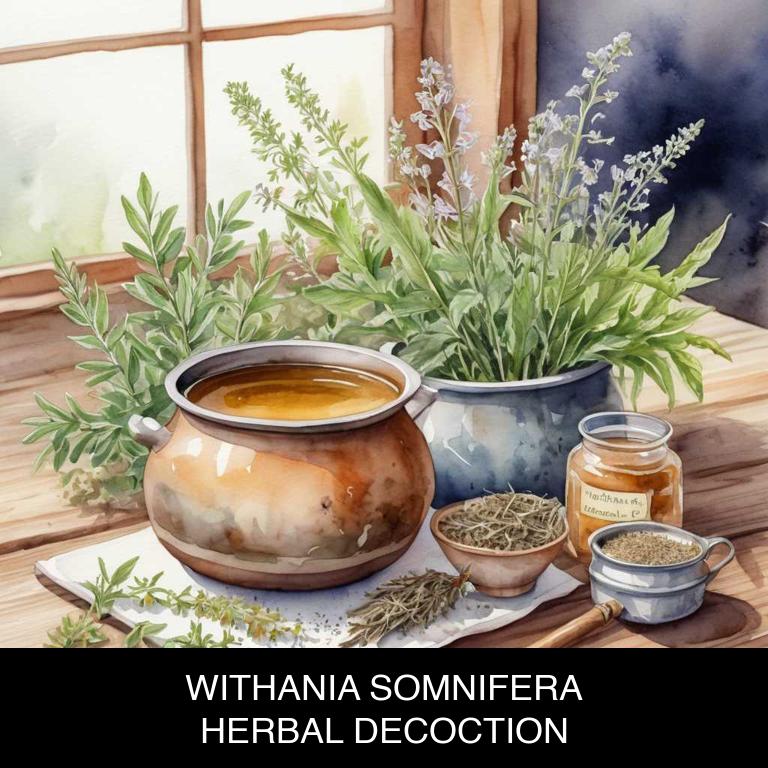
Medicinal Constituents
The list below shows the primary medicinal constituents in Withania somnifera decoctions that help with plantar fasciitis.
- Withanolides: Withanolides, a class of steroidal lactones, have anti-inflammatory properties that help reduce inflammation and pain in the plantar fascia, thereby alleviating plantar fasciitis symptoms.
- Alkaloids: These alkaloids have potent anti-inflammatory and antioxidant effects, which help reduce oxidative stress and inflammation in the plantar fascia, leading to pain relief and improved recovery from plantar fasciitis.
- Catechins: Catechins, a type of polyphenol, have anti-inflammatory and antioxidant properties that help reduce inflammation and oxidative stress in the plantar fascia, thereby alleviating plantar fasciitis symptoms and promoting healing.
Parts Used
The list below shows the primary parts of ashwagandha used to make decoctions for plantar fasciitis.
- Roots: The roots of Withania somnifera are commonly used due to their high concentration of bioactive compounds such as withanolides, which have anti-inflammatory properties that help alleviate plantar fasciitis symptoms.
- Leaves: The leaves are used due to their antioxidant and anti-inflammatory properties, which help reduce inflammation and promote healing in the affected areas of the foot.
- Seeds: The seeds are used due to their potential to reduce pain and inflammation by inhibiting the production of pro-inflammatory enzymes, thereby providing relief from plantar fasciitis.
Quick Recipe
The following recipe gives a procedure to make a basic ashwagandha for plantar fasciitis.
- Measure 2-3 grams of dried withania somnifera root powder per 8 ounces of water for a standard decoction.
- Combine the withania somnifera powder with water in a saucepan and bring to a boil over high heat.
- Reduce the heat to a simmer and let the mixture brew for 5-7 minutes or up to 15 minutes.
- Strain the decoction using a cheesecloth or a fine-mesh sieve into a clean glass container.
- Discard the solids and let the decoction cool to room temperature before serving or storing in the refrigerator.
8. Echinacea angustifolia
Kansas coneflower decoctions helps with plantar fasciitis because of its unique combination of anti-inflammatory and antioxidant properties.
The decoction's active compounds, such as echinacein and chicoric acid, have been shown to reduce inflammation and swelling in the affected area, thereby alleviating pain and stiffness associated with plantar fasciitis.
Additionally, the decoction's ability to improve blood circulation and promote collagen production helps to strengthen the plantar fascia and surrounding tissues, further reducing symptoms of this common condition.
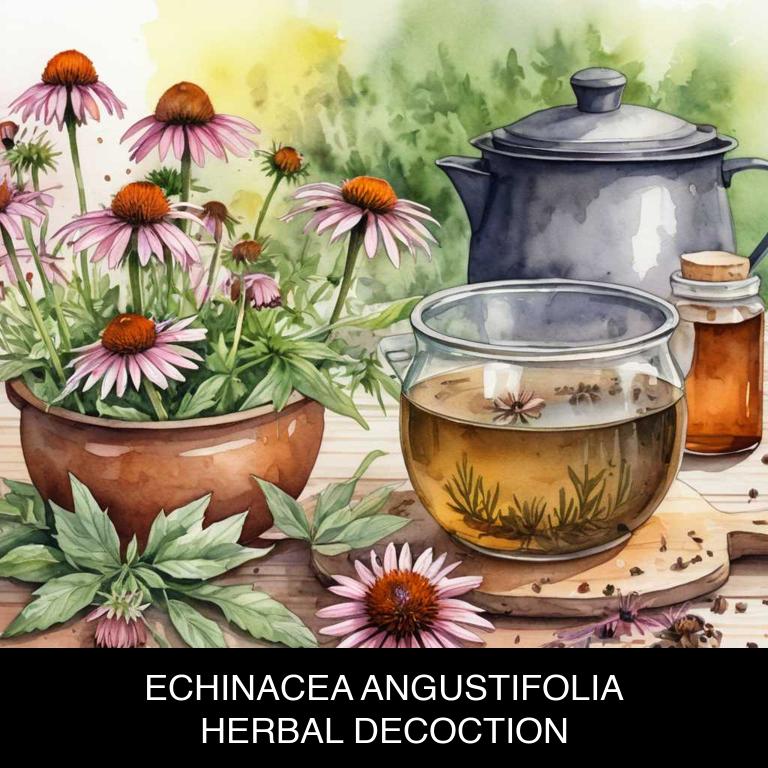
Medicinal Constituents
The list below shows the primary medicinal constituents in Echinacea angustifolia decoctions that help with plantar fasciitis.
- Iridoids: Iridoids, such as echinacoside, help with plantar fasciitis by reducing inflammation and pain due to their analgesic and anti-inflammatory properties.
- Alkylamides: Alkylamides, such as cis-jasmone, help with plantar fasciitis by reducing inflammation and promoting tissue repair due to their anti-inflammatory and healing properties.
- Flavonoids: Flavonoids, such as kaempferol, help with plantar fasciitis by reducing inflammation and pain due to their antioxidant and anti-inflammatory properties, which can help reduce oxidative stress and promote tissue repair.
Parts Used
The list below shows the primary parts of kansas coneflower used to make decoctions for plantar fasciitis.
- Roots: Used for their anti-inflammatory properties to reduce pain and swelling associated with plantar fasciitis.
- Rhyzomes: Utilized for their ability to reduce inflammation and promote healing, which can help alleviate symptoms of plantar fasciitis.
- Roots: (Again, as it is a part of the plant commonly used) They also contain compounds that can help reduce pain and inflammation, making them a common choice for decoctions.
Quick Recipe
The following recipe gives a procedure to make a basic kansas coneflower for plantar fasciitis.
- Harvest 1-2 cups of dried echinacea angustifolia root or 3-4 cups of fresh root material in late summer.
- Rinse the dried root with cold water to remove any impurities and debris for 5 minutes.
- Chop the root material into small pieces and combine it with 4 cups of water in a pot.
- Bring the mixture to a boil then reduce heat and simmer for 30-40 minutes to release active compounds.
- Strain the decoction through a cheesecloth or fine-mesh sieve into a clean container and discard solids.
9. Eucalyptus globulus
Tasmanian blue gum decoctions helps with plantar fasciitis because of its unique combination of anti-inflammatory and analgesic properties.
The decoction's bioactive compounds, such as eucalyptol and cinnamaldehyde, work together to reduce inflammation and pain in the heel and calf areas, where plantar fasciitis typically affects. Additionally, Tasmanian blue gum's mucilages help to soothe and relax irritated tissues, promoting healing and reducing stiffness.
As a result, regular consumption of this decoction may alleviate symptoms associated with plantar fasciitis, such as pain, swelling, and limited mobility.
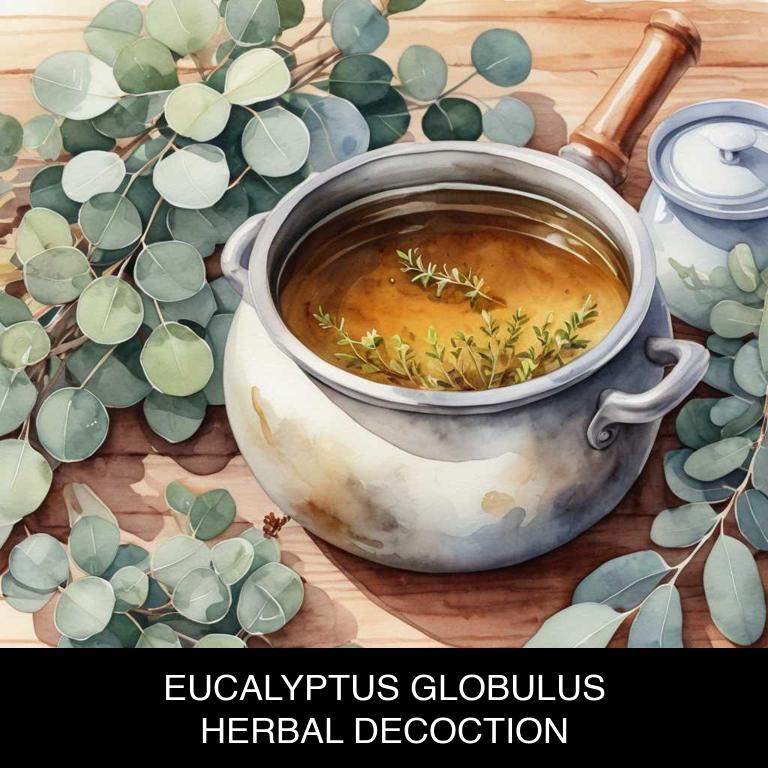
Medicinal Constituents
The list below shows the primary medicinal constituents in Eucalyptus globulus decoctions that help with plantar fasciitis.
- Eucalyptol: This terpene has anti-inflammatory properties that can help reduce pain and swelling associated with plantar fasciitis by inhibiting the production of pro-inflammatory enzymes.
- Catechin: A type of phenolic compound, catechin has antioxidant properties that can help reduce oxidative stress and inflammation in the affected area, promoting healing and reducing pain.
- Cineole: This terpene has analgesic and anti-inflammatory effects, which can help relieve pain and reduce swelling in the plantar fascia, allowing for improved mobility and reduced discomfort.
Parts Used
The list below shows the primary parts of tasmanian blue gum used to make decoctions for plantar fasciitis.
- Leaves: Leaves are the most commonly used part due to their high concentration of essential oils, which have anti-inflammatory and analgesic properties that help alleviate plantar fasciitis pain.
- Barks: Barks are used due to their antiseptic and anti-inflammatory properties, which help reduce inflammation and promote healing in the affected area.
- Roots: Roots are utilized for their anti-inflammatory and pain-relieving properties, which aid in reducing the pain and discomfort associated with plantar fasciitis.
Quick Recipe
The following recipe gives a procedure to make a basic tasmanian blue gum for plantar fasciitis.
- Measure 1 to 2 teaspoons of dried eucalyptus globulus leaves for a standard decoction.
- Combine the measured eucalyptus globulus leaves with 250 milliliters of cold water in a saucepan.
- Heat the mixture over medium heat and bring it to a gentle boil for 5 to 10 minutes.
- Reduce heat to low and simmer the decoction for an additional 10 to 15 minutes.
- Strain the decoction through a fine-mesh sieve or cheesecloth into a cup or glass.
10. Mentha x piperita
Peppermint decoctions helps with plantar fasciitis because of its anti-inflammatory properties, which help reduce swelling and pain in the affected area.
The decoction's menthol content also relaxes tense muscles and improves blood flow, easing tension on the plantar fascia. Additionally, peppermint's analgesic properties numb the pain, providing relief from discomfort and stiffness.
As a result, herbal peppermint decoctions can be a natural and effective way to alleviate symptoms of plantar fasciitis, promoting healing and reducing reliance on pharmaceuticals.
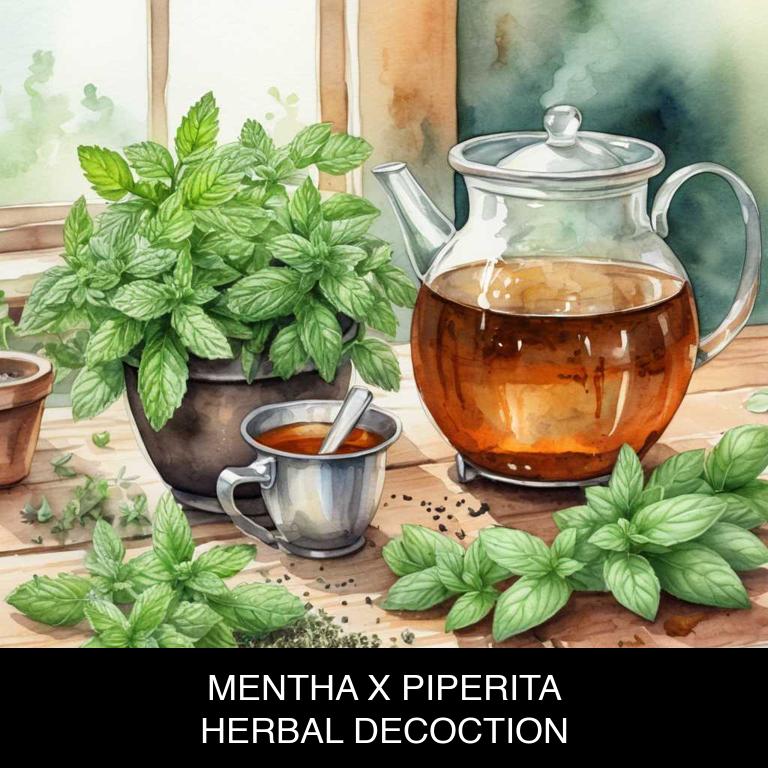
Medicinal Constituents
The list below shows the primary medicinal constituents in Mentha x piperita decoctions that help with plantar fasciitis.
- Menthol: Menthol helps with plantar fasciitis by acting as a topical anesthetic and anti-inflammatory agent, reducing pain and inflammation in the affected area.
- Limonene: Limonene, particularly d-limonene, has potent anti-inflammatory and analgesic properties, which can help alleviate pain and reduce inflammation associated with plantar fasciitis.
- Rosmarinic acid: Rosmarinic acid, a polyphenolic compound, has anti-inflammatory and antioxidant properties that can help reduce inflammation and promote healing in the affected tissues, potentially alleviating plantar fasciitis symptoms.
Parts Used
The list below shows the primary parts of peppermint used to make decoctions for plantar fasciitis.
- Leaves: They are used due to their high content of menthol, which has anti-inflammatory and analgesic properties that help to alleviate pain and reduce inflammation in the affected area.
- Stems: They are used for their antioxidant and anti-inflammatory properties, which help to reduce swelling and ease pain in the plantar fascia.
- Roots: They are used for their anti-inflammatory properties, which help to reduce swelling and ease pain in the plantar fascia, making them a common ingredient in decoctions for plantar fasciitis relief.
Quick Recipe
The following recipe gives a procedure to make a basic peppermint for plantar fasciitis.
- Harvest 1/4 cup of fresh mentha x piperita leaves and flowers in the early morning for highest oil content.
- Chop the harvested plant material into small pieces to release its essential oils and flavor compounds.
- Combine the chopped plant material with 2 cups of boiling water in a heat-resistant container to create the decoction.
- Steep the mixture for 5-7 minutes to allow the bioactive compounds to infuse into the water.
- Strain the decoction through a cheesecloth or a fine-mesh sieve into a clean container to remove solids.
What is the best combination of herbal decoctions to use for plantar fasciitis?
The best combination of herbal decoctions that help with plantar fasciitis is a blend of turmeric, ginger, and willow bark.
Turmeric's anti-inflammatory properties reduce swelling and pain, while ginger's warming properties ease stiffness and promote circulation. Willow bark contains salicin, a natural pain reliever similar to aspirin.
Combine equal parts of these three decoctions, steep for 5-7 minutes, and drink 2-3 times a day. This herbal blend can help alleviate plantar fasciitis symptoms, promoting healing and recovery.
Consult with a healthcare professional before using herbal remedies.
What ailments similar to plantar fasciitis are treated with herbal decoctions?
Ailments similar to plantar fasciitis that are treated with herbal decoctions are tendinitis, shin splints, and Achilles tendonitis.
Herbal decoctions containing herbs like ginger, turmeric, and cayenne pepper can help reduce inflammation and alleviate pain in these conditions. Additionally, decoctions made from herbs such as devil's claw, willow bark, and stinging nettle may also provide relief by reducing pain and swelling.
These herbal remedies can be used in conjunction with conventional treatment for optimal results.